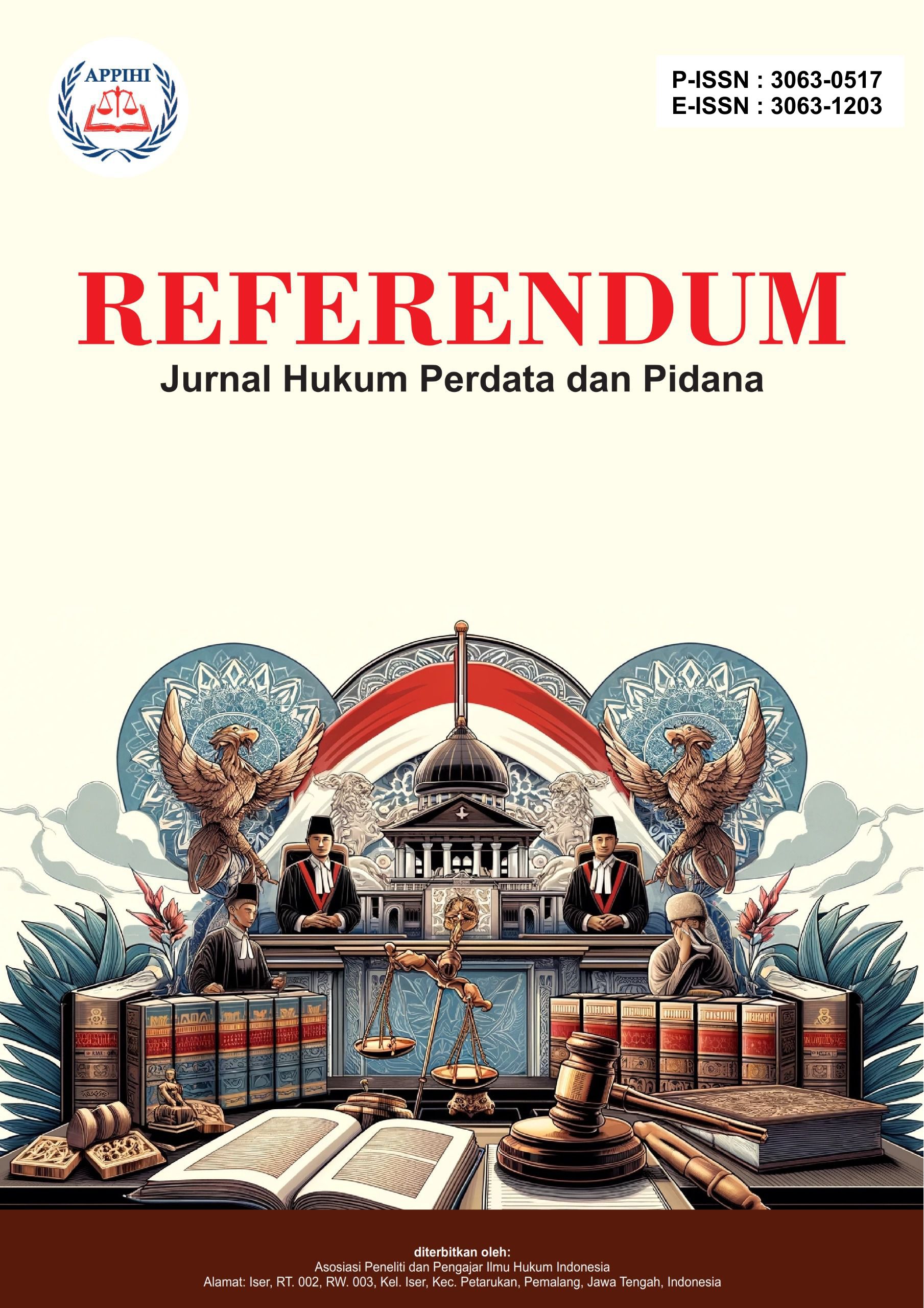Reimajinasi Sistem Pembuktian: Apakah Era Post-Faktual Membutuhkan Standar Baru dalam Hukum Acara Pidana?
DOI:
https://doi.org/10.62383/referendum.v2i2.666Keywords:
Criminal Law, Post-Factual, System of EvidenceAbstract
The post-factual era has shifted the position of legal facts from objective entities to part of narrative contestations shaped by digital disinformation, algorithmic media, and unverified public perception. Unfortunately, this has given rise to epistemic dislocation in the judicial process, where evidence loses its objective quality, legal decisions are distorted by collective emotional pressure and erode the credibility of the law as a guarantor of substantive and procedural justice. This research is a normative research using a conceptual approach. The data collection method was collected using library research, then analyzed using qualitative methods and presented descriptively. The results of the study show that the development of disinformation, emotional narratives, and manipulative digital evidence have shown a structural inconsistency between conventional evidentiary standards and the complexity of 21st-century legal realities, threatening the validity of evidence, the autonomy of judicial institutions, and the principle of due process in the criminal system. Therefore, it is necessary to reconstruct the evidentiary system through the integration of verification technology, cross-disciplinary collaborative approaches, and investment in digital literacy, to ensure that the law continues to function as a rational and fair instrument in an increasingly unstable information landscape.Downloads
References
Abdul Azis. (2022). Law enforcement through social media pressure. Law and Justice, 7(1), 89–97.
Alexey Yu. Stebivko. (2024). Software and data support for computer forensic analysis. Legal Concept, 23(3), 189–194.
Aminuddin, A. (2022). Menghadapi disinformasi konten berita digital di era post truth. Jurnal Lensa Mutiara Komunikasi, 6(2), 283–292.
Anju. (2024). Exploring the impact of social media on public opinion formation: A comparative analysis. International Journal for Research in Applied Science & Engineering Technology, 12(4), 307–311.
Aven, T., & Flage, R. (2023). A risk science perspective on liability/guilt and uncertainty judgements in courts. Risk Analysis, 43(1), 1525–1532.
Baryse, D., & Sarel, R. (2024). Algorithms in the court: Does it matter which part of the judicial decision-making is automated? Artificial Intelligence and Law, 32(1), 117–146.
Buckleton, J., Taylor, D., Bright, J.-A., Hicks, T., & Curran, J. (2021). When evaluating DNA evidence within a likelihood ratio framework, should the propositions be exhaustive? Forensic Science International: Genetics, 50(1), 1–11.
Chin, J. M., Edmond, G., & Roberts, A. (2022). Simply unconvincing: The High Court on probative value and reliability in the uniform evidence law. Federal Law Review, 50(1), 104–127.
Cuellar, M., Mauro, J., & Luby, A. (2022). A probabilistic formalisation of contextual bias: From forensic analysis to systemic bias in the criminal justice system. The Journal of the Royal Statistical Society, 185(2), 620–643.
Ferreira Ribeiro, G. (2021). Evidentiary policies through other means: The disparate impact of “substantive law” on the distribution of errors among racial groups. Utah Law Review, 4(2), 441–478.
Kadir, Z. K. (2025). Konflik keyakinan hakim: Analisis perbandingan conviction intime di Prancis dan conviction raisonnée di Portugal. Jurnal Ilmiah Multidisiplin Ilmu, 2(2), 60–71.
Köchling, A., Riazy, S., Wehner, M. C., & Simbeck, K. (2021). Highly accurate, but still discriminatory: A fairness evaluation of algorithmic video analysis in the recruitment context. Business & Information Systems Engineering, 63(1), 39–54.
Magalhães, P. C., & Garoupa, N. (2020). Judicial performance and trust in legal systems: Findings from a decade of surveys in over 20 European countries. Social Science Quarterly, 101(1), 1743–1760.
Mappaselleng, N. F., & Kadir, Z. K. (2020). Hukum acara pidana adversarial. Arti Bumi Intaran.
Modgil, S., Singh, R. K., Gupta, S., & Dennehy, D. (2021). A confirmation bias view on social media induced polarisation during Covid-19. Information Systems Frontiers, 26(2), 1–25.
Negii, S., Jayachandran, M., & Upadhyay, S. (2021). Deep fake: An understanding of fake images and videos. International Journal of Scientific Research in Computer Science, Engineering and Information Technology, 7(3), 183–189.
Rogerson, M., & Parry, G. C. (2020). Blockchain: Case studies in food supply chain visibility. Supply Chain Management: An International Journal, 25(5), 601–614.
Shillito, M. R. (2019). Untangling the ‘dark web’: An emerging technological for the criminal law. Information & Communications Technology Law, 28(2), 186–207.
Syahuri, T., & Saputra, M. R. (2024). Penggunaan teknologi dalam proses peradilan serta dampaknya terhadap akses keadilan (access to justice). Amandemen: Jurnal Ilmu Pertanahan, Politik dan Hukum Indonesia, 1(3), 1–14.
Winson-Kovacs, D., Helm, R., Growns, B., & Redfern, L. (2023). Digital evidence in defence practice: Prevalence, challenges and expertise. The International Journal of Evidence & Proof, 0(0), 1–19. https://doi.org/10.1177/13657127231168889 (catatan: tambahkan DOI jika tersedia)
Yerlikaya, T., & Toker Aslan, S. (2020). Social media and fake news in the post-truth era: The manipulation of politics in the election process. Insight Turkey, 22(2), 177–196.
Zhang, J., & Han, Y. (2022). Algorithms have built racial bias in legal system—Accept or not? Advances in Social Science, Education and Humanities Research, 631(1), 1217–1221.
Downloads
Published
How to Cite
Issue
Section
License
Copyright (c) 2025 Referendum : Jurnal Hukum Perdata dan Pidana

This work is licensed under a Creative Commons Attribution-ShareAlike 4.0 International License.






